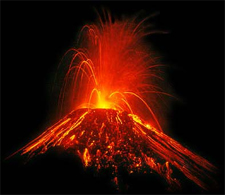Rare melt key to 'Ring of Fire'
07 Oct 2010
Oxford University scientists have discovered the explanation for why the world's explosive volcanoes are confined to bands only a few tens of kilometres wide, such as those along the Pacific 'Ring of Fire'. Most of the molten rock that comes out of these volcanoes is rich in water, but the Oxford team has shown that the volcanoes are aligned above narrow regions in the mantle where water-free melting can take place. They publish a report of their research in this week's Nature.
 These volcanic chains have been responsible for the most devastating eruptions in history, such as that of Krakatoa in 1883, and the huge eruption of Toba about 74,000 years ago, whose aftermath may have come close to extinguishing the human race.
These volcanic chains have been responsible for the most devastating eruptions in history, such as that of Krakatoa in 1883, and the huge eruption of Toba about 74,000 years ago, whose aftermath may have come close to extinguishing the human race.
"It has been recognised for almost 50 years that the volcanic arcs form where one oceanic plate sinks beneath another," said Professor Philip England of Oxford University's department of earth sciences, an author of the report, "but while many models of this process have been put forward, none has been able to explain the location, and narrowness, of the volcanic arcs."
The eruptions of volcanoes in the Ring of Fire are extremely violent (in contrast with the relatively gentle eruption in Iceland that paralysed European air travel in April) because the molten rock contains a high proportion of water which, as superheated gas, provides the power for the explosive eruptions. This water is liberated from the plates descending beneath the volcanoes and lowers the melting point of rocks in the mantle.
"Most previous explanations for the origins of volcanoes suggested that this kind of 'wet' melting is responsible for getting a volcano started," said Dr Richard Katz of Oxford University's department of earth sciences, an author of the report. The difficulty with such explanations is that wet melting occurs over very broad regions of the mantle, inconsistent with the narrowness of the volcanic chains. "However, we noticed that there is a very simple geometrical pattern in the distribution of the volcanoes which provides a powerful clue as to what is going on," added Dr Katz.
Using a mathematical model of heat transport in the regions where two plates collide, the Oxford team showed that the observed geometrical pattern can only be explained if the volcanoes are localized above the narrow regions in which mantle melts in the absence of water. Melt rising from this region blazes a trail for more water-rich magma to follow all the way to the surface where it erupts to form volcanoes.
In addition to hosting devastating eruptions, the volcanic chains hold valuable clues to the evolution of the earth, because they are the surface expressions of a gigantic chemical factory in which molten rock separates from the mantle to solidify as the crust we live on, and from which significant volumes of gas are emitted into the atmosphere. The team now intends to investigate the implications of their results for the chemical processes happening deep beneath the volcanic chain.






.webp)















